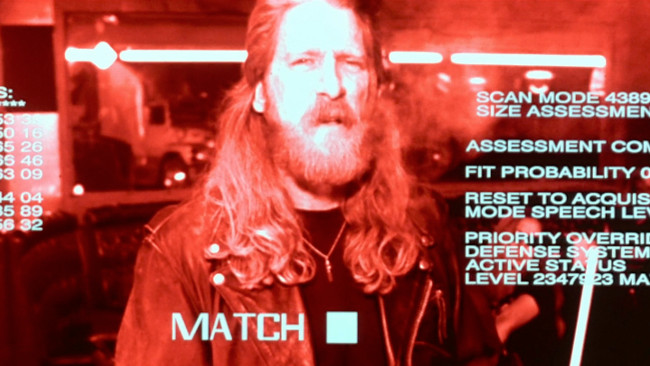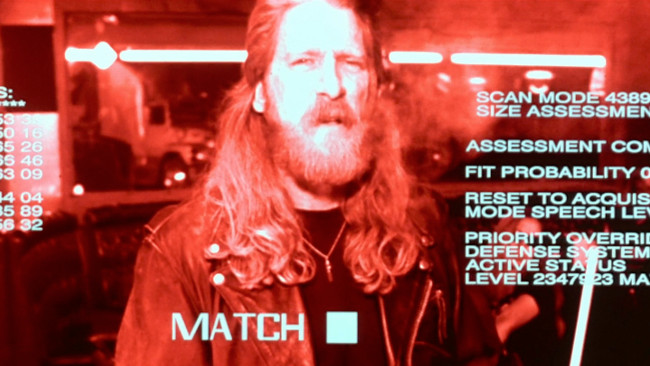
 The T-800's POV from Terminator 2
The T-800's POV from Terminator 2
Before any of us heard of the phrase 'augmented reality', we were primed for its arrival through point of view shots from a robot's perspective in 1991's Terminator 2.
We are nearing the 25th anniversary of the box office release for one of the most iconic sequels of all time, Terminator 2. I'm sure that the film inspires nostalgia and fond memories for many of our readers over a certain age. If you haven't seen it in awhile, check it out again. It holds up remarkably well for an action film released two and a half decades ago.
I'm using the occasion of this milestone anniversary to discuss one of the enduring (and endearing) aspects of that film, one that has direct relevance to the present and forthcoming commercial technologies that aim to transform how we view and interact with visual content. I'm speaking specifically about Terminator vision.
Through the eyes of a robot
[Ed's Note: Light Spoilers ahead!]
In James Cameron's Terminator 2, the robotic T-800 model 101, as played by Arnold Schwarzenegger, arrived into town naked. In the now-famous scene, the Terminator POV was established as the T-800 entered a biker bar, searching for suitable clothes and a means of transportation. In essence, we saw through the T-800's eyes: the red tinted world and a rush of text and information as a graphical overlay. Here's a short video of Terminator vision scenes strung together (again, for those that have not seen the film, there may be some spoilers in the video):
At the time (and even now), Terminator vision is an implausible means of seeing the world for the T-800. When one ponders Terminator vision for any length of time, the device loses credibility as a tool for a robot. Why would a robot need what amounts to a heads-up display? Such an advanced mechanism would undoubtedly be able to parse this information without needing to display it as a human textual language or even as images in an adjunct layer of its visual field, which would be wholly inefficient.
It's perhaps unfair to nitpick over such details, as Terminator vision works fantastically as a storytelling device within the film. Credit must also be given to Cameron and his team for popularizing the concepts that would coalesce and become what we now know as augmented reality. In creating Terminator vision, Cameron did not give us the way a robot sees the world, but rather the way that many of us humans wanted to see the world. Sure, the images could have been higher res and less 'red' and the graphics more sophisticated (Hollywood has continually refined this style over years), but Terminator 2 created a template that still stands as a de facto benchmark for actual augmented reality prototypes and products decades later.
Terminator vision in the real world
While Terminator vision may have just been a flight of fancy at its cinematic inception, in the convening years, such capabilities have inched closer and closer into being for humans. Following the new defunct Google Glass, what immediately leaps to mind, pardon the pun, is the ultra-secretive, partially Google-funded startup Magic Leap, which uses light field technology to create dimensional, holographic images in the wearer's field of view (or, at least, part of the FOV), not to mention Microsoft's Hololens, an AR product that will be a likely middle-ground between Glass and Leap, and the Meta 2 AR headset, which aims to replicate the Hololens experience at a much lower price (for the dev kit).
Magic Leap POV
But, what if you want to see something a little closer to the actual Terminator vision, as represented in Terminator 2? Through the camera view of the HTC Vive virtual reality headset, you can see a view of your environs that resembles the tinted Terminator vision, as explained in this video by YouTube user Jeffrey Grubb of Venture Beat:
Going one step further, a "hardware hacking team" from the German firm TNG Technology Consulting GmbH, achieved Terminator Vision with an Oculus Rift DK2 and Intel RealSense F200 3D camera in a one-day developer's challenge last year:
However, in order to be truly faithful to the film's AR system, the user shouldn't need to wear a headset or even glasses. While we're many years away from implantable commercial augmented reality systems (if they arrive at all), the US military is experimenting with just such a device. The Defense Advanced Research Projects Agency (DARPA), perhaps best known for the role it played in the development of the internet, is working on a cortical modem which, according to CNET, "plugs into your DNA and your visual cortex to cure sight loss and show a heads-up display in front of your very eyes."
Who knows when or if such implantable technology will see the commercial light of day, but it's hard to deny the profound effect that Terminator 2's vision of robot vision has had on the development of real virtual and augmented reality devices. Terminator vision is, at once, evocative of the past, the present and, possibly, the future, whether or not the robot apocalypse comes to pass.
Tags: VR & AR


Comments